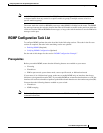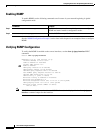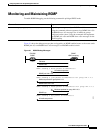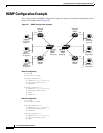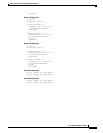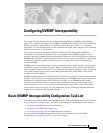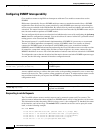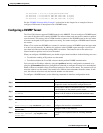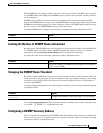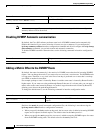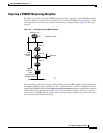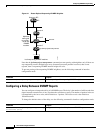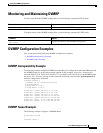
Configuring DVMRP Interoperability
Basic DVMRP Interoperability Configuration Task List
IPC-539
Cisco IOS IP Configuration Guide
171.69.214.203 -> 0.0.0.0 [1/0/pim/querier/down/leaf]
171.69.214.18 -> 171.69.214.20 (mm1-45e.cisco.com) [1/0/pim]
171.69.214.18 -> 171.69.214.19 (mm1-45c.cisco.com) [1/0/pim]
171.69.214.18 -> 171.69.214.17 (mm1-45a.cisco.com) [1/0/pim]
See the “DVMRP Interoperability Example” section later in this chapter for an example of how to
configure a PIM router to interoperate with a DVMRP router.
Configuring a DVMRP Tunnel
The Cisco IOS software supports DVMRP tunnels to the MBONE. You can configure a DVMRP tunnel
on a router if the other end is running DVMRP. The software then sends and receives multicast packets
over the tunnel. This strategy allows a PIM domain to connect to the DVMRP router in the case where
all routers on the path do not support multicast routing. You cannot configure a DVMRP tunnel between
two routers.
When a Cisco router runs DVMRP over a tunnel, it advertises sources in DVMRP report messages much
as it does on real networks. In addition, the software caches DVMRP report messages it receives and
uses them in its Reverse Path Forwarding (RPF) calculation. This behavior allows the software to
forward multicast packets received over the tunnel.
When you configure a DVMRP tunnel, you should assign a tunnel an address in the following two cases:
• To enable the sending of IP packets over the tunnel
• To indicate whether the Cisco IOS software should perform DVMRP summarization
You can assign an IP address either by using the ip address interface configuration command, or by
using the ip unnumbered interface configuration command to configure the tunnel to be unnumbered.
Either of these two methods allows IP multicast packets to flow over the tunnel. The software will not
advertise subnets over the tunnel if the tunnel has a different network number from the subnet. In this
case, the software advertises only the network number over the tunnel.
To configure a DVMRP tunnel, use the following commands in interface configuration mode:
Command Purpose
Step 1
Router(config-if)# interface tunnel number
Specifies a tunnel interface in global configuration mode
and puts the router into interface configuration mode.
Step 2
Router(config-if)# tunnel source ip-address
Sets the source address of the tunnel interface. This address
is the IP address of the interface on the router.
Step 3
Router(config-if)# tunnel destination
ip-address
Sets the destination adddress of the tunnel interface. This
address is the IP address of the mrouted multitask router.
Step 4
Router(config-if)# tunnel mode dvmrp
Configures a DVMRP tunnel.
Step 5
Router(config-if)# ip address address mask
or
Router(config-if)# ip unnumbered type number
Assigns an IP address to the interface.
or
Configures the interface as unnumbered.
Step 6
Router(config-if)# ip pim [dense-mode |
sparse-mode]
Configures PIM on the interface.
Step 7
Router(config-if)# ip dvmrp accept-filter
access-list [distance | ip neighbor-list
access-list]
Configures an acceptance filter for incoming DVMRP
reports.



